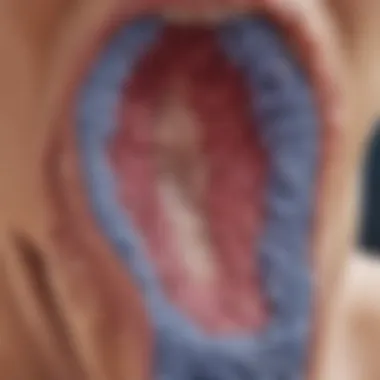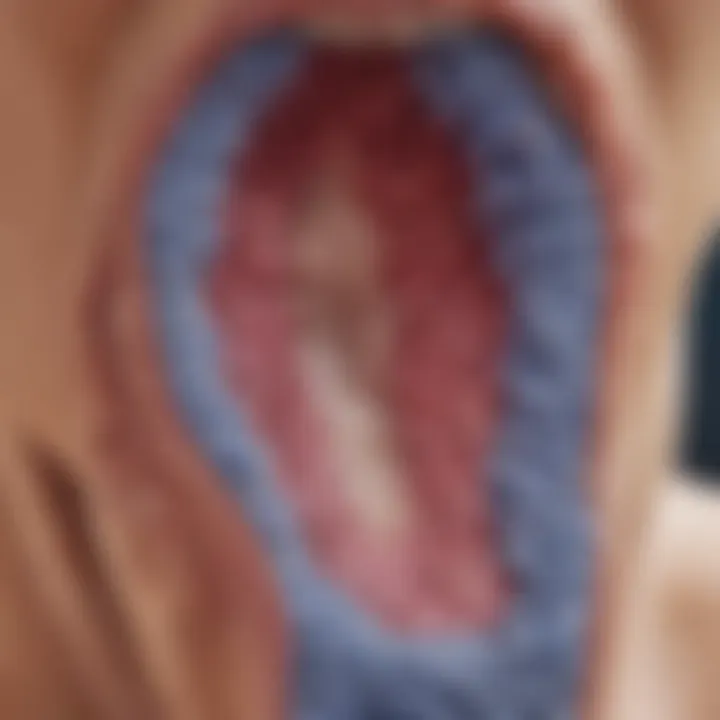Papillary vs Follicular Thyroid Cancer: Key Differences


Intro
Thyroid cancer represents a significant health concern, with papillary and follicular variants being the most common. Understanding these two types is essential for healthcare professionals and researchers alike. This article aims to detail the differences between papillary and follicular thyroid cancer, providing a clear analysis of their unique characteristics. The discussion will encompass epidemiology, clinical presentation, diagnostic methods, treatment options, and prognostic outcomes.
Recent Advances
Latest Discoveries
Research in the field of thyroid cancer has seen remarkable progress. Recently, studies have uncovered key genetic mutations associated with both papillary and follicular thyroid cancers. The identification of specific genetic markers contributes to more personalized approaches in treatment and prognostic evaluation. For instance, mutations in the BRAF gene have been primarily linked to papillary thyroid cancer, suggesting a potential focus for targeted therapies.
Moreover, advanced imaging techniques have enhanced the accuracy of diagnoses. Real-time ultrasound and innovative PET scans allow for a better understanding of the tumor's characteristics and spread. Overall, these discoveries help sharpen the strategies for early detection and management.
Technological Innovations
Technology plays a pivotal role in improving outcomes for patients suffering from thyroid cancer. The advent of minimally invasive surgical techniques has transformed how these cancers are treated. For example, robotic-assisted thyroidectomy has been increasingly adopted, offering patients a quicker recovery and less postoperative discomfort. Furthermore, intraoperative neuromonitoring has emerged as a crucial tool for preserving the integrity of vocal cord function during surgery.
The integration of artificial intelligence in diagnostic procedures is also noteworthy. AI algorithms can analyze large datasets of imaging and pathology, assisting physicians in making more reliable and timely diagnoses. This application of technology represents a significant shift in the management of thyroid cancer.
"The intersection of genomics and technology holds profound promise for the future of thyroid cancer treatment, directing focus toward precision medicine."
Methodology
Research Design
The analyses included in this article have been derived from a systematic review of current literature. The research methodology focused on qualitative and quantitative studies, spanning a range of epidemiological data up to the year 2023.
Data Collection Techniques
Data was gathered from multiple reliable sources, including clinical trials, patient registries, and peer-reviewed journals. This comprehensive approach allows for an in-depth examination of both papillary and follicular thyroid cancers, framing them within the larger context of thyroid malignancies.
Preface to Thyroid Cancer
Thyroid cancer has gained significant attention in the medical community due to its increasing incidence and the diverse types that exist. Understanding this topic is critical, as it lays the foundation for better awareness and management strategies. This section will provide clarity on what thyroid cancer is, its types, and how these factors contribute to our larger knowledge of papillary and follicular thyroid cancer.
Definition of Thyroid Cancer
Thyroid cancer originates in the thyroid gland, which is located at the base of the neck. This malignancy arises when normal cells in the thyroid undergo abnormal changes, leading to uncontrolled growth. Thyroid cancer is categorized into several distinctive types that vary in their aggressiveness, treatment, and overall patient outcomes. The majority of cases are identified as differentiated thyroid cancers, which are generally more treatable.
Types of Thyroid Cancer
Understanding the types of thyroid cancer is paramount for diagnosis and treatment. The main categories include differentiated and undifferentiated types.
Overview of Differentiated Thyroid Cancers
Differentiated thyroid cancers encompass papillary and follicular thyroid cancers. The key characteristic of these cancers lies in their origin from follicular cells of the thyroid. This is beneficial for patients because differentiated cancers often respond well to treatment.
The unique feature of differentiated thyroid cancers is their generally indolent behavior. This means they tend to grow slowly, allowing for more favorable prognostic outcomes. Strategies such as surgical removal and radioactive iodine therapy typically yield high success rates in treating these cancers.
Overview of Medullary and Anaplastic Thyroid Cancers
In contrast, medullary and anaplastic thyroid cancers present unique challenges. Medullary thyroid cancer arises from C-cells, which produce calcitonin. This cancer type is less common and can be sporadic or hereditary. Its key characteristic is its potential to be aggressive, making it a less favorable choice in terms of prognosis
Anaplastic thyroid cancer, while rare, is highly aggressive. It often presents at an advanced stage, complicating treatment efforts. Recognizing these forms of thyroid cancer is essential because they demand different clinical approaches and significantly impact overall patient management.
Overview of Papillary Thyroid Cancer
Papillary thyroid cancer (PTC) represents the most prevalent form of thyroid malignancy, accounting for approximately 80% of all thyroid cancers. Understanding PTC is critical for healthcare professionals and researchers alike as it guides effective diagnostic and treatment strategies. The distinct characteristics of PTC influence not only the approach to management but also the prognosis of patients diagnosed with this cancer.
In this section, we will explore several essential aspects of papillary thyroid cancer, including its epidemiology, histological features, and risk factors. These elements are crucial for a well-rounded understanding of the disease and are integral to the broader comparison with follicular thyroid cancer.


Epidemiology and Incidence
Papillary thyroid cancer predominantly affects women, with a notable female-to-male ratio often cited as high as 3:1 or 4:1. The incidence of PTC has risen significantly over the past few decades, likely due to improved detection methods and greater awareness of thyroid diseases. According to data, PTC represents about 90% of all diagnosed thyroid cancers in certain populations. It is often found in younger individuals, commonly between the ages of 30 and 50.
Additionally, geographic factors may contribute to varying incidence rates. High iodine intake in certain regions correlates with increased detection of PTC, while in others, the rates remain lower.
Histological Features
Histologically, papillary thyroid cancer is characterized by unique features that distinguish it from other forms of thyroid cancer. The cancer typically arises from follicular cells and exhibits papillary structures, hence its name. Under microscopic examination, the presence of nuclear features like the following may be noted:
- Nuclear grooves
- Inclusions
- Optically clear nuclei
These distinct histological markers are critical for pathologists to identify PTC accurately during biopsies. Moreover, tumor size and presence of extra-thyroidal extension can affect staging and management decisions.
Risk Factors
Several risk factors are associated with the development of papillary thyroid cancer. These factors may include:
- Genetic predisposition: A family history of thyroid cancer increases the risk.
- Radiation exposure: Previous exposure to radiation, especially in childhood, is a well-documented risk factor.
- Autoimmune conditions: The presence of conditions like Hashimoto's thyroiditis can associate with a higher risk.
- Iodine intake: Both high and low levels of iodine in the diet might contribute to the risk of developing PTC.
It is important to assess these risk factors during patient evaluation for appropriate monitoring and management.
"Understanding the epidemiology, histology, and risk factors of papillary thyroid cancer informs clinical practices and improves patient outcomes."
Overview of Follicular Thyroid Cancer
Understanding follicular thyroid cancer within this analysis is essential due to its distinct characteristics that separate it from papillary thyroid cancer. While both types belong to the category of differentiated thyroid cancers, they each exhibit unique epidemiological data, histological histories, and risk factors. Exploring these nuances facilitates a deeper understanding for medical professionals and researchers, which can lead to improved patient management and treatment strategies.
Epidemiology and Incidence
Follicular thyroid cancer is the second most common type of thyroid cancer. The incidence rate varies by geographic region, sex, and age. Research suggests that it accounts for approximately 10-15% of all thyroid carcinoma cases. In the United States, the overall incidence has been steadily increasing, partly due to enhanced detection methods and increased awareness.
When observing specific demographics, women are more commonly affected than men, with a ratio of around 3:1. Those between the ages of 40 and 60 are particularly at risk. Additionally, populations in iodine-deficient areas display a higher incidence, which correlates with the influence of iodine on thyroid function.
Histological Features
Histologically, follicular thyroid cancer is characterized by the formation of follicular structures. These neoplastic follicles are lined by cuboidal or columnar epithelial cells. A defining histological feature is the presence of vascular invasion, which can distinguish follicular carcinoma from benign follicular adenomas.
The differentiation of follicular thyroid cancer into minimally invasive and widely invasive types is crucial, as it impacts the prognosis and treatment options. Minimally invasive cancers are often associated with better outcomes, while widely invasive forms tend to have a more aggressive behavior.
Risk Factors
Certain risk factors have been identified for follicular thyroid cancer, including:
- Iodine Deficiency: This remains a significant contributor, emphasizing the role of dietary iodine levels in thyroid health.
- Age and Gender: As mentioned earlier, older adults and females are at greater risk.
- Family History: A personal or family history of thyroid diseases may increase susceptibility.
- Radiation Exposure: Individuals exposed to radiation, particularly during childhood, are at a higher risk.
Understanding these risk factors helps in developing screening recommendations and potential preventative measures for at-risk populations.
Pathological Comparisons
Pathological comparisons between papillary and follicular thyroid cancer are essential for accurate diagnosis and treatment strategies. Both types of thyroid cancer arise from follicular cells, but they exhibit distinct biological behaviors and clinical outcomes. Understanding these differences can help medical professionals tailor interventions and predict prognostic outcomes.
Cell of Origin
Papillary thyroid cancer originates from the follicular cells of the thyroid. These cells are responsible for synthesizing and secreting thyroid hormones. Histologically, papillary carcinoma displays characteristic papillary structures and often includes psammoma bodies, which are calcified structures found within the tumor. This distinct pattern is a key diagnostic criterion.
In contrast, follicular thyroid cancer also arises from follicular cells but differs in how the cells grow and invade surrounding tissues. It typically forms encapsulated tumors that, upon invasion through the capsule, may lead to metastasis. The distinction between these growth patterns plays a significant role in management and prognosis.
Genetic Mutations


Genetic mutations are pivotal in understanding the pathological differences between papillary and follicular thyroid cancer. Papillary thyroid cancer commonly involves mutations in the BRAF gene, which is associated with aggressive tumor behavior. Two frequently observed alterations are BRAF V600E and RET/PTC rearrangements, which contribute to the neoplastic transformation and progression of the disease.
Follicular thyroid cancer, on the other hand, often shows mutations in the RAS gene and alterations in the PI3K/AKT signaling pathway. These genetic changes can affect the tumor's growth and steroid production and influence the effectiveness of certain therapies.
Understanding these genetic alterations not only improves diagnostic accuracy but also aids in identifying patients who may benefit from targeted therapies.
Key Takeaway: Pathological comparisons help delineate the fundamental differences in origin and mutations between papillary and follicular thyroid cancer, ultimately guiding clinical decisions and improving patient outcomes.
Clinical Presentation
The clinical presentation of thyroid cancer is vital for early detection and effective management. Understanding the symptoms associated with papillary and follicular thyroid cancers allows healthcare professionals to provide timely information and care. Recognizing the signs also fosters better patient awareness, leading to earlier diagnosis.
Symptoms of Papillary Thyroid Cancer
Papillary thyroid cancer often presents with subtle symptoms during its early stages. Many patients may not experience noticeable changes. However, some common symptoms may include:
- A notable lump or nodule in the neck, generally painless.
- Swelling in the neck or surrounding areas.
- Changes in voice, such as hoarseness or difficulty speaking.
- Difficulty swallowing as the tumor progresses.
It is important to note that these symptoms can occur in other conditions, emphasizing the need for proper diagnostic procedures. Though papillary thyroid cancer tends to grow slowly, early intervention remains crucial in improving overall outcomes.
Symptoms of Follicular Thyroid Cancer
Follicular thyroid cancer might display a different set of symptoms compared to its papillary counterpart. Patients may encounter:
- A visible mass in the neck, also usually painless.
- Symptoms related to thyroid metabolism, such as weight changes, either gain or loss unexpectedly.
- Fatigue, which can be persistent and impact daily activities.
- Swelling of lymph nodes in the neck region.
Similar to papillary thyroid cancer, the symptoms of follicular thyroid cancer can mimic other health issues. This overlap underscores the necessity for advanced imaging studies and biopsies to obtain a definitive diagnosis.
Early detection of symptoms associated with both types of thyroid cancer is critical. This enables discussions about potential treatment options and management strategies.
Overall, understanding the clinical presentation is an essential step in navigating thyroid cancer. Both patient education and healthcare provider awareness can significantly impact treatment pathways and patient outcomes.
Diagnostic Approaches
The diagnostic approaches for thyroid cancer are critical for determining the appropriate management for patients. Early and accurate diagnosis can significantly influence the treatment plan and the subsequent outcomes. This section will delve into the essential elements of diagnostic methodologies, focusing on their advantages and necessary considerations.
Imaging Techniques
Imaging plays a vital role in the diagnostic pathway for thyroid cancer. Various techniques are employed to visualize abnormalities in the thyroid gland. Common imaging methods include:
- Ultrasound: This non-invasive technique is often the first imaging modality used when a thyroid nodule is suspected. It provides real-time images and helps characterize the nodule’s features, including its size, composition, and vascularity.
- Computed Tomography (CT): CT scans offer detailed cross-sectional images of the neck and can help identify any lymph node involvement or distant metastases. They are particularly useful in complex cases where more detailed anatomical information is necessary.
- Magnetic Resonance Imaging (MRI): While not commonly used for initial thyroid cancer detection, MRI can be beneficial in assessing local invasive disease and soft tissue involvement when the extent of disease is suspected.
- Positron Emission Tomography (PET): This imaging technique is typically used in advanced cases. It helps to evaluate metabolic activity and can identify metastases that may not be apparent on other imaging tests.
Imaging techniques are essential not only for diagnosis but also for tracking the response to therapy over time. By accurately visualizing the cancer's progression or regression, healthcare providers can adjust treatment plans as necessary. Despite the strengths of these methods, it is essential to consider potential limitations, such as the risk of false positives or negatives, which may lead to unnecessary procedures or missed diagnoses.
Biopsy and Cytology
Biopsy and cytological evaluation are crucial for a definitive diagnosis of thyroid cancer. These procedures allow for the examination of cellular characteristics that are indicative of malignancy. Key aspects of these diagnostic techniques are as follows:
- Fine Needle Aspiration (FNA): FNA is the most common biopsy method used for thyroid nodules. It involves inserting a thin needle into the nodule to withdraw cells for analysis. This technique is minimally invasive and has a high sensitivity rate, making it effective for diagnosing both papillary and follicular thyroid cancer.
- Cytological Examination: The cells obtained from an FNA are subjected to microscopic examination. Cytologists assess the cells for features that suggest malignancy. Common criteria include cell arrangement, nuclear characteristics, and background material. The presence of atypical cells can lead to further investigation or concern.
- Core Needle Biopsy: In some cases, a core needle biopsy may be used to retrieve a larger tissue sample. This method can provide additional information about the tumor architecture and is particularly useful in cases where FNA results are inconclusive.
- Considerations: Although biopsy techniques are generally safe and effective, they may still carry risks of complications, such as bleeding or infection. Additionally, the interpretation of cytology can vary, emphasizing the need for experienced cytopathologists to enhance diagnostic accuracy.
Treatment Options
In the realm of thyroid cancer management, particularly for papillary and follicular types, treatment options hold critical importance. The correct approach can significantly influence the overall prognosis and quality of life for patients. Understanding the various options allows healthcare professionals to tailor treatments that not only address the cancer but also consider patient-specific factors such as age, health status, and personal preferences.
This section delves into the primary treatment options available, including surgical interventions, radioactive iodine therapy, and targeted therapies. By grasping these elements, professionals can better navigate the complexities of thyroid cancer treatment.
Surgical Interventions
Surgical intervention serves as the cornerstone for treating both papillary and follicular thyroid cancers. The primary aim of surgery is to remove the tumor and affected thyroid tissue. In many cases, total thyroidectomy—the complete removal of the thyroid gland—is recommended, especially when the cancer is diagnosed at a later stage or there's concern for aggressive behavior.


- Types of Surgery:
- Total Thyroidectomy: Total removal of the thyroid gland. Recommended for more extensive disease.
- Lobectomy or Thyroid Lobectomy: Removal of one lobe. Suitability varies based on tumor size and type.
Post-surgery, patients typically require lifelong monitoring through hormone replacement therapy, as the body can no longer produce thyroid hormones naturally. Complications from surgery, although infrequent, can include injury to surrounding structures like the parathyroid glands or recurrent laryngeal nerve.
Radioactive Iodine Therapy
Radioactive iodine therapy is a widely used adjunctive treatment post-surgery, particularly for papillary thyroid cancers. This approach involves ingesting a radioactive form of iodine, which is selectively absorbed by remnant thyroid tissue and any remaining cancer cells.
- Benefits:
- Effective for Residual Cancer: Targets cells that might have been missed during surgery.
- Minimally Invasive: Often administered as an outpatient procedure.
It's critical to monitor patient levels of thyroid-stimulating hormone (TSH) before applying this treatment, as a higher TSH level increases the efficacy of the therapy. Additionally, patients may experience side effects such as fatigue or dry mouth, which are typically transient.
Targeted Therapies
Targeted therapies represent a more recent advancement in the treatment landscape for thyroid cancers. These therapies focus on specific genetic mutations associated with these malignancies. In cases where papillary or follicular cancers show mutations in genes like BRAF or RAS, targeted therapies—such as vemurafenib for BRAF mutations—may be indicated.
- Considerations:
- Effectiveness: Patients with specific genetic profiles may benefit significantly compared to traditional therapies.
- Side Effects: As with all medications, side effects may include rash, fatigue, and changes in liver function.
Integrating targeted therapies into treatment plans allows for a more personalized approach, enhancing the potential for successful outcomes.
Ultimately, the treatment decisions require a multi-disciplinary team to evaluate all the factors surrounding the patient's case. This yields a treatment plan that is ethical, practical, and sensitive to the individual's needs.
By understanding these treatment options, both medical professionals and patients can engage in informed discussions that encourage better management of thyroid cancer.
Prognostic Outcomes
Understanding prognostic outcomes is critical for healthcare professionals dealing with thyroid cancer, specifically papillary and follicular types. Prognostic outcomes encompass the likelihood of recovery, survival rates, and overall patient well-being after diagnosis and treatment. These elements can help clinicians tailor treatment plans and provide patients with realistic expectations. This analysis also aids in identifying the best treatment pathways by analyzing various factors that can influence survival and quality of life. Comprehensive knowledge in this area is beneficial not only for medical experts but also for patients and their families.
Survival Rates
Survival rates in thyroid cancer vary significantly between papillary and follicular types. For papillary thyroid cancer, the 5-year survival rate is exceptionally high, often exceeding 90%. This statistic is indicative of the generally favorable prognosis associated with this subtype, largely due to its slow growth and responsiveness to treatment. In contrast, follicular thyroid cancer presents a slightly different scenario. The 5-year survival rate for follicular thyroid cancer tends to range between 75% and 90%, depending on various patient-specific factors such as age, stage at diagnosis, and overall health.
"Clinical outcomes in thyroid cancer depend significantly on histological type and stage at diagnosis."
Factors Influencing Prognosis
Several factors are critical in determining the prognosis for patients with thyroid cancer. These can be categorized as follows:
- Age of the Patient: Younger patients generally have better survival rates compared to older individuals, who may face more complications and slower recovery.
- Tumor Size and Stage: Larger tumors and those diagnosed at a more advanced stage exhibit lower survival odds. Early detection plays a vital role in better outcomes.
- Histological Type: As mentioned, papillary thyroid cancer typically has a better prognosis than follicular thyroid cancer, influencing treatment decisions and expected outcomes.
- Response to Initial Treatment: How well a patient responds to surgery and therapies like radioactive iodine can be indicative of long-term outcomes.
A thorough understanding of these factors can empower healthcare professionals to provide targeted care while equipping patients with the knowledge needed to engage meaningfully in their treatment decisions.
Culmination
Understanding the distinctions between papillary and follicular thyroid cancer is crucial for many stakeholders, including patients, healthcare providers, and researchers. Both types of thyroid malignancies share some characteristics, yet they diverge significantly in their pathology, treatment options, and prognostic outcomes. This article serves to clarify those differences, highlighting essential elements that have implications for diagnosis and management.
Summary of Key Differences
Papillary thyroid cancer often presents as multifocal and is the most common type of thyroid cancer. It is characterized by slow growth and an excellent prognosis, with a high survival rate. On the other hand, follicular thyroid cancer has a propensity for vascular invasion, potentially leading to a higher risk of metastasis. It can be more aggressive than papillary cancer, underscoring the importance of careful assessment and treatment planning for patients. Specific differences include:
- Epidemiology: Papillary thyroid cancer is more prevalent than its follicular counterpart.
- Histological Features: While both tumors derive from follicular cells, papillary thyroid cancer typically demonstrates characteristic nuclear features.
- Treatment Approaches: Surgical options and radioactive iodine therapy may vary based on the type and stage of cancer.
- Prognostic Factors: Papillary thyroid cancer generally results in better outcomes relative to follicular thyroid cancer, which may show variability in survival based on certain risk factors.
Understanding these differences aids in tailoring treatment strategies to optimize patient outcomes and provides a framework for future research pursuits.
Future Directions in Research
The landscape of thyroid cancer research is continually evolving, leading to promising areas for exploration. Future research can enhance our knowledge in several domains, including:
- Genetic and Molecular Pathways: A deeper understanding of the genetic mutations associated with these cancers can lead to targeted therapies, improving patient prognosis.
- Longitudinal Studies: Investigating long-term outcomes across diverse populations can provide valuable insights into the effectiveness of treatment protocols.
- Comparative Effectiveness Research: Identifying which treatment modalities work best in specific patient populations aids in personalizing therapy.
- Patient Quality of Life: Further research into the quality of life for survivors of both types is critical for holistic patient care.















